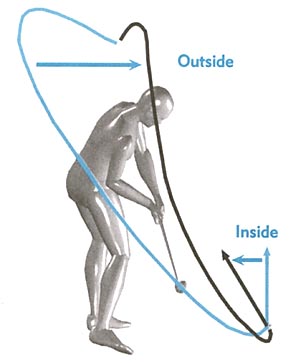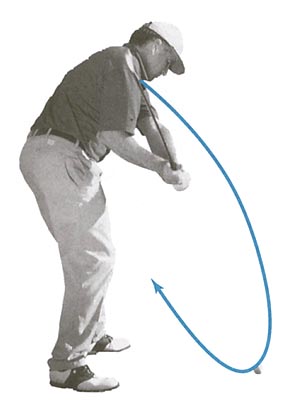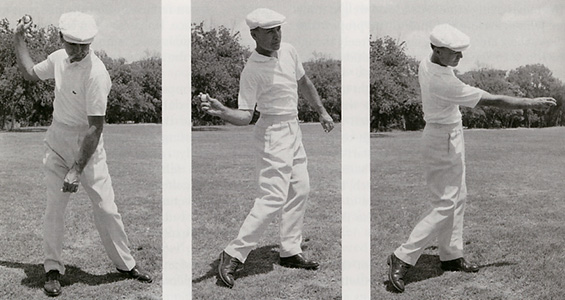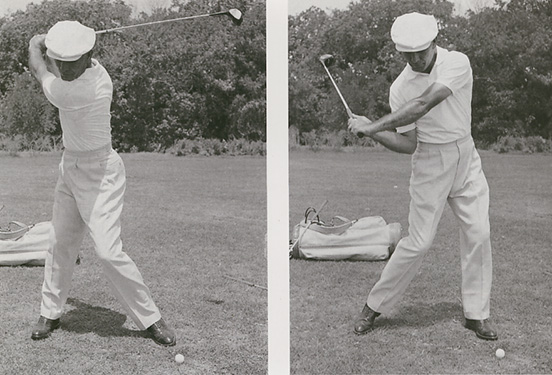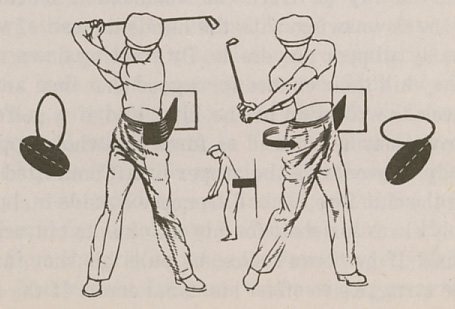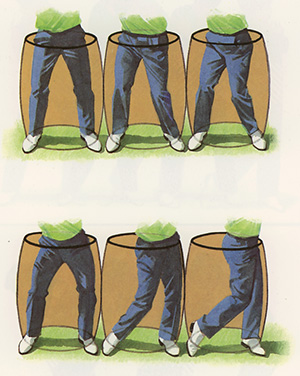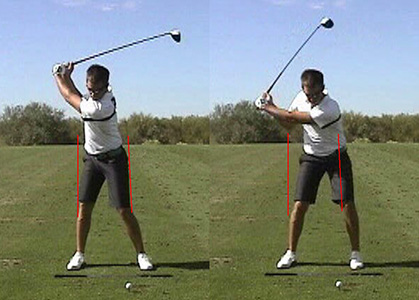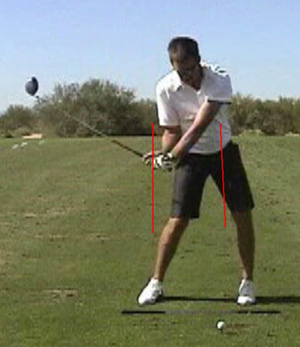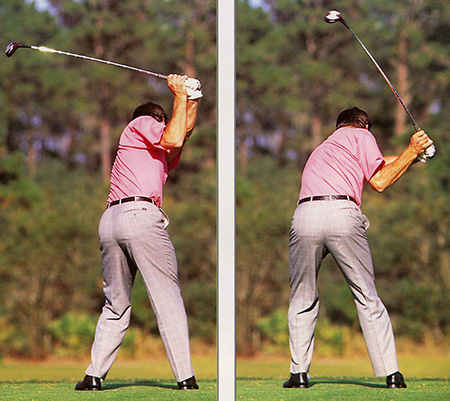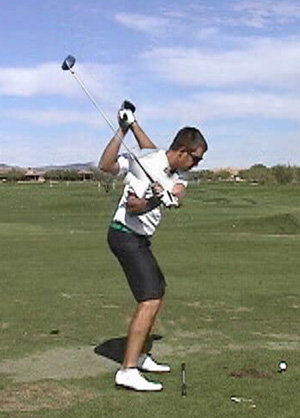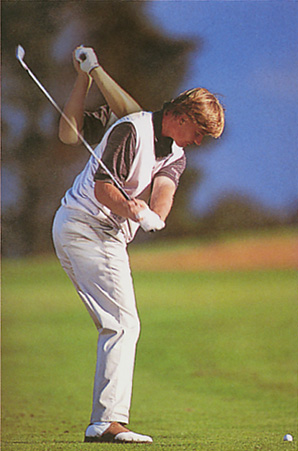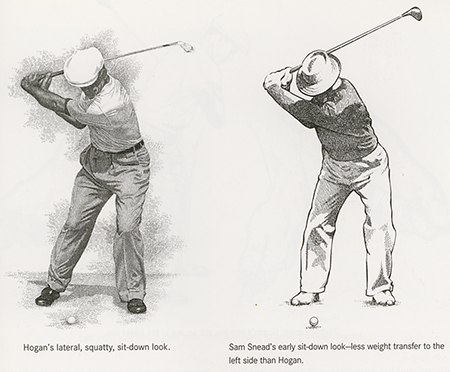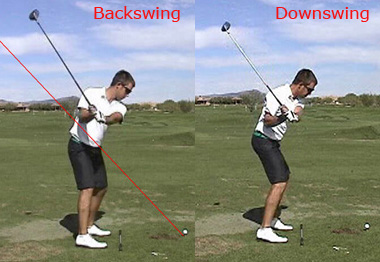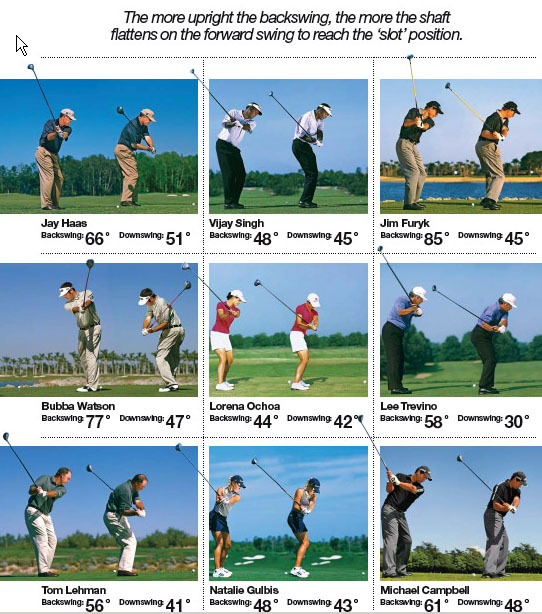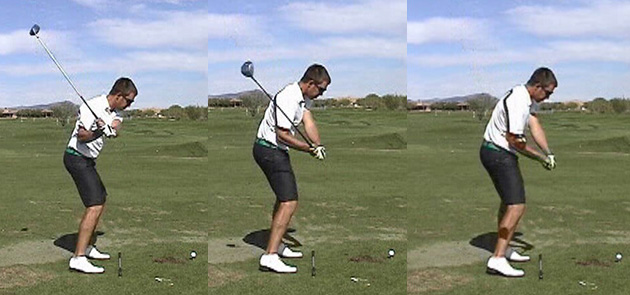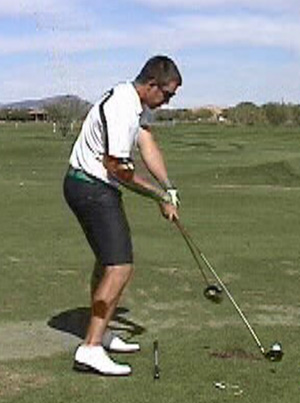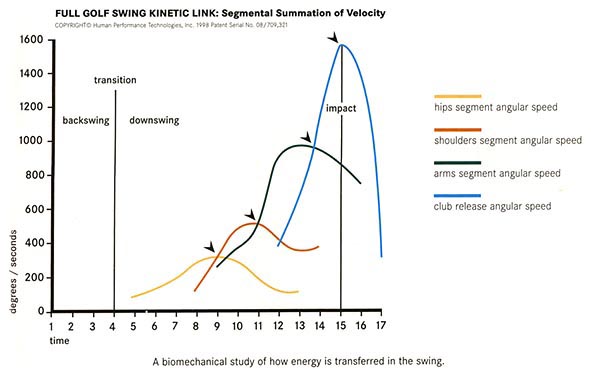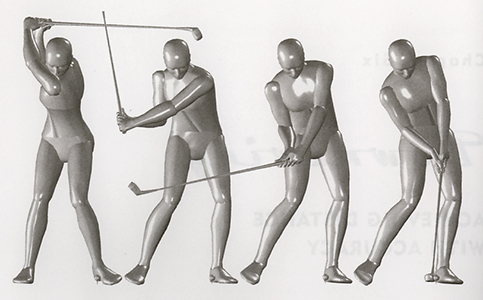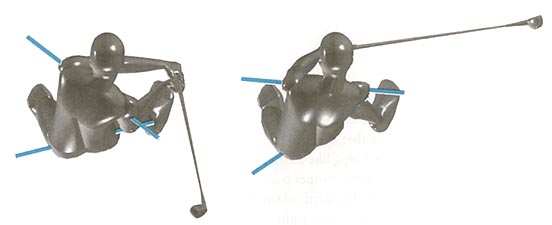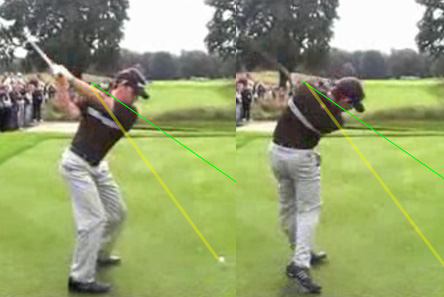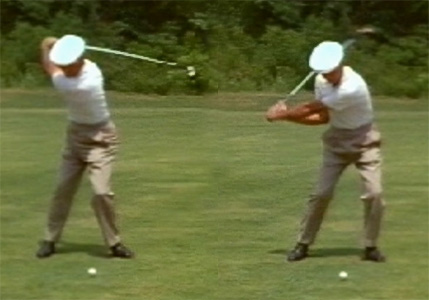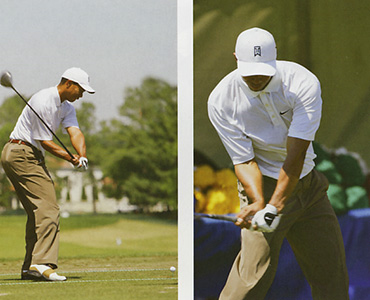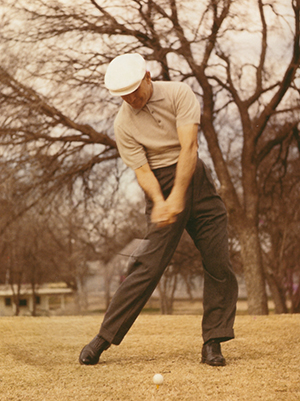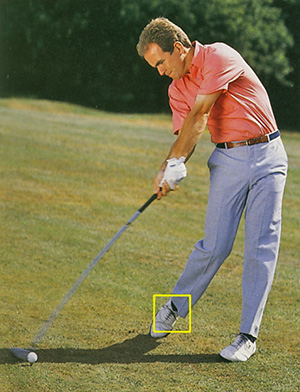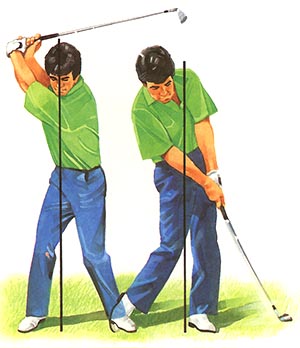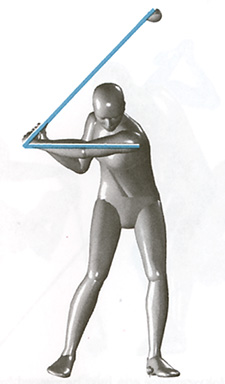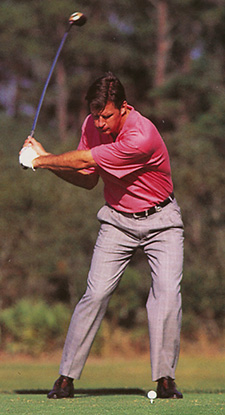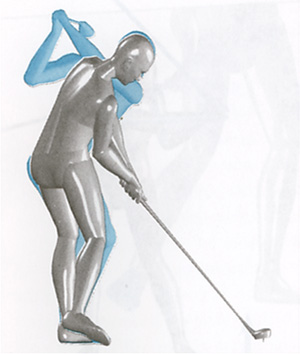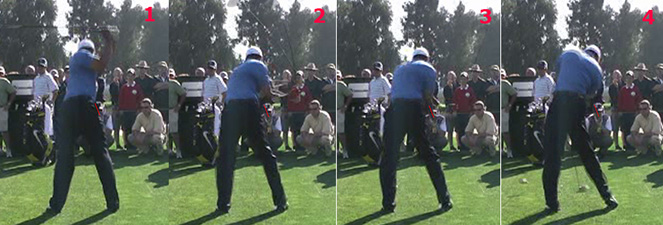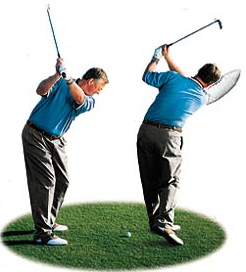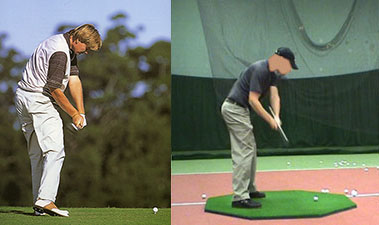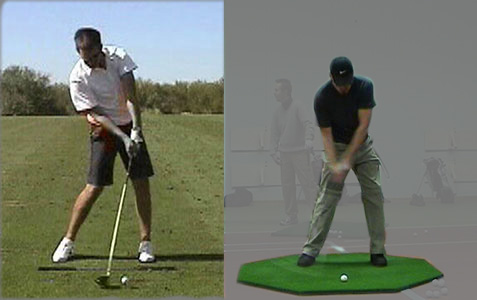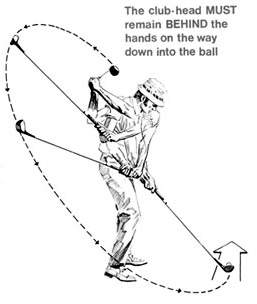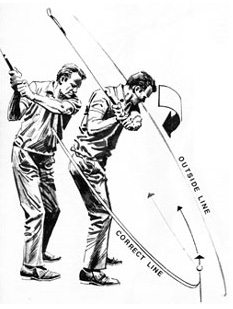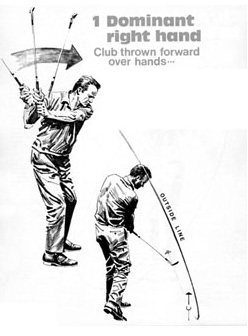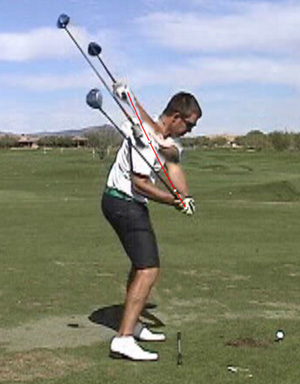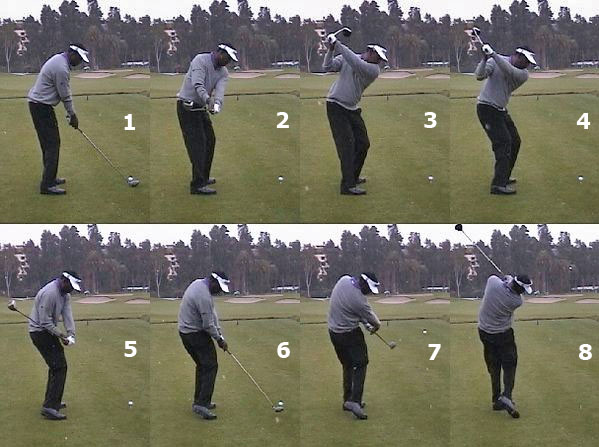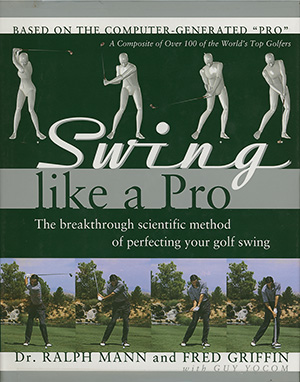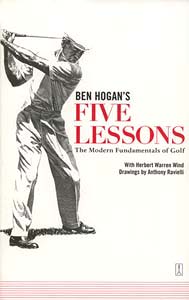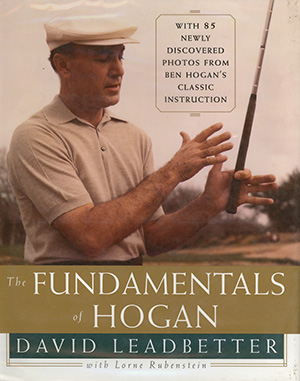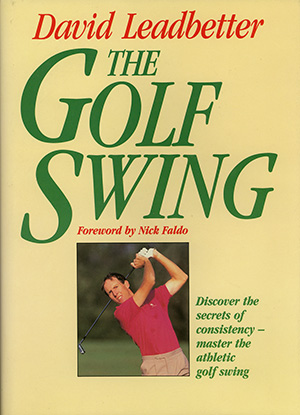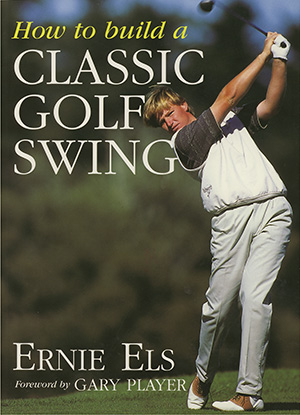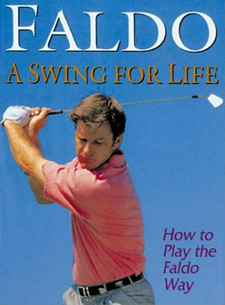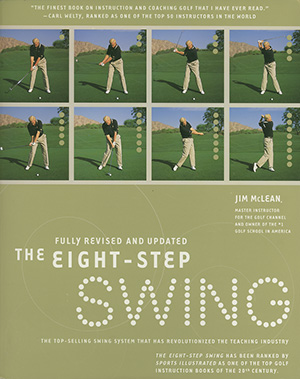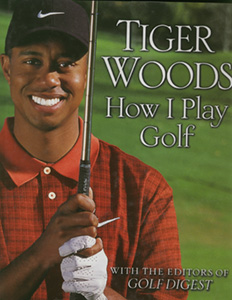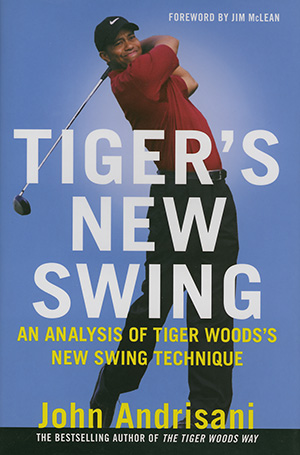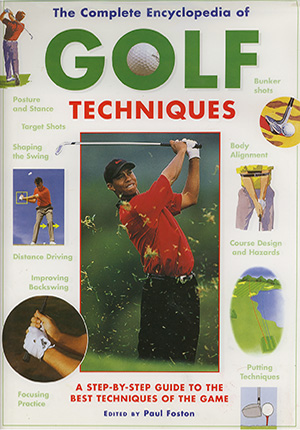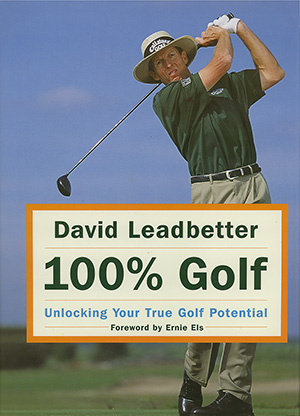Downswing
Click on any of the hyperlinks to rapidly navigate to another section of the review: Homepage (index); overview; grip; address setup; backswing; impact; followthrough-to-finish
In this section of the critical review, I am going to be using the swing of Aaron Baddeley as an ideal role model for the modern, total body swing. I obtained a video of Aaron Baddeley's swing from the V1 Home swing Analyser website (http://v2.v1home.com) [1]. I then created many screen captures of Aaron Baddeley's swing at different points in his swing, so that I could point-out certain important positions, movements, and swingpaths. However, there is no substitute for seeing a swing evolve in continuous motion, and I cannot do that in this critical review. I, therefore, highly recommend that you visit the V1 Home Swing Analyser website and download their free version of the swing analyser. You can also freely download Aaron Baddeley's swing from the website (the down-the-line Driver video and the face-on Driver video). That will enable you to play back his swing in slow motion, or frame-by-frame, while following this review. It will greatly enhance your ability to learn how to execute a perfect golf swing. I also encourage you to purchase the basic version of the V1 Home Swing Analyser for $39. The basic version has the advantage that you can play back two different versions of a golf swing, side-by-side. If you video your swing, you will then be able to compare your own swing to Aaron Baddeley's (or another PGA tour golfer's) swing at any point in the swing. You will then quickly learn if you are getting into the correct positions, and you may quickly learn what you have to do to improve your swing.
Note - Aaron Baddeley has recently made changes to his swing, and this swing video therefore doesn't necessarily represent his latest swing.
Introduction
The first downswing move is the most critical part of the modern, total golf swing, and it has been referred to as the modern, total body golf swing's "magical move". Getting this "magical move" right is absolutely essential to a good golf swing. I personally think that it is essential to get all parts of the golf swing right, but I can understand why so many golf instructional books regard the first downswing move as being very critical to a good golf swing. Many beginner golfers get this first downswing move totally wrong, as exemplified in this diagram of a high handicapper, beginner golfer's downswing clubhead swingpath [2].
Downswing clubhead swingpath - from reference number [2]
The Swing Like a Pro (SLAP) researchers [2] found that the downswing clubhead swingpath of high handicapper, developing golfers (in black) is usually much steeper than the downswing clubhead swingpath of professional golfers (in blue). There are two major reasons for this phenomenon. The first reason relates to the fact that high handicapper, beginner golfers often have a backswing swingplane that is too-flat in its first half, and too-steep in its second half - due to lifting of the hands after the hands get "stuck" as a result of the initially too-flat backswing swingplane - and the imperfect backswing swingplane consequently gets the beginner golfer's hands into the wrong end-backswing position. More importantly, the high handicapper, beginner golfer starts the downswing with an upper body move, rather than a lower body move.A high handicapper, beginner golfer often starts the downswing by simultaneously performing two upper body moves - i) pulling the club down actively with his hands; ii) actively turning the right shoulder down towards the ball. Those two upper body moves throws the clubshaft forward towards the ball-target line, and the clubhead soon crosses the toe-line. From that point on, the clubhead passes along a steep path down to the ball and reaches the ball from a slightly outside-in direction, which causes a pull (if the clubface is square at impact), a pull-hook (if the clubface is closed at impact) or a pull-slice (if the clubface is open at impact). Beginner golfers who execute this over-the-top move sometimes seem to be spinning their shoulders in a circle around a passive lower body (pelvis) and inactive legs. As a beginner golfer gains more experience, and more control, he learns to minimise the spinning motion and he steepens his shoulder turn - and this produces a downswing motion, which the SLAP authors call the "upper body dive". The upper body dive can be perceived to an upper body move that gives an outside observer an impression that the beginner golfer is lunging at the ball with his upper body, as demonstrated in this photo from the "Swing Like a Pro" book [2].
Upper body dive - from reference [2]
You can sense that the beginner golfer (model) is throwing his upper body into the ball. Note that the right shoulder is well forwards, and it is starting to cross over the toe-line, and note that the hands have been thrown away from the body and well forward of the toe-line. To complete the shot, the beginner golfer (model) executes an outside-in swingpath by pulling his hands across the body. He then subsequently completes the followthrough by moving his hands inside and around-the-body in a low followthrough swingpath.Consider the "real-life" series of images of an anonymous golfer performing an "upper body dive" downswing movement..
Anonymous golfer performing an "upper body dive" downswing movement
Note how the anonymous golfer starts the downswing with an upper body movement (right shoulder rotation) that throws the hands and clubhead over the toe line along a steep downswing path. Note how the steep "over-the-top" movement of the hands then produces an outside-in clubhead swingpath as the anonymous golfer pulls his hands inwards towards his body during the remainder of the downswing and early followthrough.To correct this problem, the beginner golfer needs to re-think his entire approach to the downswing, so that he can achieve a PGA tour player-style downswing clubhead swingpath.
Downswing clubhead swingpath - from reference number [2]
Consider the downswing clubhead swingpath of an idealised professional golfer model - The ModelPro (in blue).Note that the clubhead first moves backwards (away from the ball-target line and towards the tush line) before it descends in a shallower arc towards the ball along an inside track. How does the professional golfer execute this backwards move (away from the body, away from the ball-target line) of the clubhead in the early downswing. You may imagine that the ModelPro golfer deliberately, and actively, first pulls the clubshaft backwards with his hands and then secondly loops it down to the ball. However, the hands are actually passive in the modern, total body downswing, and the clubhead first moves backwards (away from the body, away from the ball-target line) because the first downswing move is a lower body move. That is the key element in the modern, total body downswing - the lower body moves first, and the upper body follows. If a beginner golfer gets to understand this complicated downswing process by reading the rest of the downswing section of this review, then he may be armed with enough theoretical knowledge to enable him to mimic the perfect downswing clubhead swingpath of a professional golfer.
Starting the downswing - the magic move
Ben Hogan, the famous golfer, can be considered to be the originator of our fundamental ideas regarding the modern golf swing, and he described his ideas about this critical downswing move in his famous book "Five Lessons" [3] first published in 1957.Ben Hogan stated that one should think of starting the golf downswing from the ground up. In other words, the downswing should start with the lower body moving first, and the upper body moving second.
Ben Hogan stated that the motion of the modern golf downswing is very similar to the motion of a baseball infield player throwing a side-throw (half side-arm, half underhand) ball to the first baseman.
These are famous photographs of Ben Hogan demonstrating this side-throw ball throwing motion in posed (simulated slow motion) photographs.
Ben Hogan performing a side throw movement - from reference number [4]
As you can see from the photographs, a ball thrower first inaugurates the side-throw ball-throwing action with a lower body (hip) rotation towards the target. Then, secondly and near simultaneously, the ball thrower lowers the right elbow to the hip area so that the right elbow leads the hands. The right shoulder is held back initially and only catches up with the hips in the latter part of the throwing motion just before the ball is released from the hands. The sequence of movements can be thought of as occurring in the following manner-: hips shift to the left and turn, and the lower body weight is simultaneously transferred to the left side => right elbow moves down to the right hip area with the right hand held back behind the right elbow (after the right hip has "cleared" thus making space for the right elbow) => right shoulder turns across the front of the body and eventually under the chin, while the hips continue turning, causing the right arm to be flung passively across the body (right arm becomes extended by centrifugal and forearm muscle forces) => right elbow straightens, right wrist unhinges, and the ball is released.If you think of this ball throwing action, you can see that the initiating power of the throw comes primarily from the rotation of the torso (first lower torso, then upper torso) and not from any active movement of the arms or hands. In fact, the hand only holds onto the ball until the ball is released secondary to centrifugal forces working through the arms to the hands; but initially actuated, and subsequently powered, by the rotating torso. To throw with even great power, the thrower will actively use the right forearm muscles during the right elbow release action in a "twist-and-throw' motion that causes the back of the right hand to face partially skywards in the followthrough - and this forearm "twist and throw" motion can supplement the ball-throwing power generated by the large muscles of the central torso.
Ben Hogan also said that one should conjure a mental image of a boy skipping flat stones across a still pond. The boy would deliberately lower the plane of his side-throw throwing action so that the stone would travel nearly parallel to the ground - in order to increase the likely number of skips-across-the-pond.
Ben Hogan stated that one should think of the golf downswing in a similar manner - as a side-throwing (stone skipping) action across the body, whereby the clubshaft angle is flattened during the downswing.
Ben Hogan simulating the initial downswing motion - from reference number [4]
Note five important features of Ben Hogan's simulated initial downswing action-: i) The hips shift-rotate around to the left and lead the downswing; ii) the right elbow leads the hands in the initial downswing; iii) the right shoulder drops down in the direction of the ball and the right arm is brought close to the torso; iv) the 90 degree angle between the left forearm and clubshaft remains unchanged in the initial downswing; v) and the clubshaft plane is relatively shallow (flattened) causing the clubshaft to bisect the right upper arm in the second photo.Interestingly, many professional golfers, who use the modern, total body golf swing, have this same "look" at this point in the downswing - even if they have relatively steep backswings (see many later photos).
If you look at Ben Hogan's leg movements, you will notice that the left knee is bent, and the left heel is seemingly unweighted at the end of the backswing. Then during the initial hip shift-rotation movement, the left knee moves away from the right knee and the left heel is actively replanted as weight is transferred onto the left foot. In other words, if the downswing starts from the ground-up, then the first downswing movement must be a replanting of the left heel + weight transfer to the left foot, followed by knee seperation, followed by hip shift-rotation. Because these three movements occur near-simultaneously, a beginner golfer should primarily think of two major lower body movements when initiating the downswing - replanting the left heel and shift-rotating the hips to the left.
If you look at Ben Hogan's hips, you can sense that the initiating hip movement is primarily a rotation of his left buttock backwards (away from the ball-target line and towards the tush line) - as if he were turning his left back trouser pants pocket back away from the ball-target line in a left hip clearing action.
Ben Hogan has an interesting diagram in his book [4] highlighting this initiating hip movement.
Idea of an elastic strip - from reference number [3]
Ben Hogan stated that one should "imagine, that at address, one end of an elastic strip is fastened to a wall directly behind your left hip and that the other end is fastened to the left hip bone." Then, during the backswing, when the hips rotate 45 degrees to the right, the elastic strip becomes stretched. The downswing starts when the elastic strip snaps back, rapidly rotating the left hip around to the left. In other words, the initiating hip movement is a rapid shift-rotation of the left hip back around to the left (hip squaring action). It is important to realise that a slight lateral shift of the pelvis to the left must precede the rotation of the the left hip around to the left - in order to get sufficient weight onto the left leg to stabilise the left leg. One needs to shift enough weight onto the left leg, so that the left hemi-pelvis can effectively pivot over the left femoral head, which will then cause the left-hemi pelvis to rotate backwards away from the ball-target line. The pulling back of the left hemi-pelvis causes the pelvis (hips) to become squared.
Addendum added June 2007: I have written a detailed review paper on the "correct" hip pivot movement . This review paper provides much more explanatory detail regarding this important downswing lower body movement, and it is available in the miscellaneous topic section of this website.
If a beginner golfer starts the downswing with a pure rotatory hip movement, rather than a shift-rotation hip movement, that pure rotatory hip movement will cause the right hemi-pelvis to rotate forward of the toe line, and it may cause his shoulders to spin around and the right shoulder will immediately be thrown forward of the toe-line (an "over-the-top" death move that must definitely be avoided). The right shoulder must be held back behind the toe line, and not cross the toe line in the early downswing. By starting the downswing with a shift-rotation of the hips (a hip squaring action due to a pulling back of the left hemi-pelvis), the beginner golfer will experience a right shoulder "side-bending feeling" - a "feeling" that the right shoulder is dropping downwards - and he should have the "side-bending feeling" of trying to drop the right shoulder into the slit opening of his right front trouser's pocket. Note how the golfer's right shoulder has dropped downwards in the above pencil diagram, as the right elbow moves rapidly down to the right hip area at the start of the downswing. To achieve that "side-bending feeling", a beginner golfer will also have the feeling that the spine is tilting away from the target. A more advanced player must avoid making a conscious effort to lower the right shoulder too much by sliding the hips too much to the left in the early downswing, because an exaggerated right shoulder side-bending downswing action (right shoulder tilting action) can result in a clubshaft plane that comes too much from the inside, and the right elbow will get stuck behind the right hip. The right shoulder should rotate in a rounded arc around the bent-over spine, and not tilt straight down towards the ground.
Here is a link to an excellent video of Ben Hogan demonstrating the initiating shift-rotation move of the hips - http://www.youtube.com/watch?v=QL_6M_xZvq0
Note how Ben Hogan starts the downswing by pulling his left hemi-pelvis back away from the ball-target line.
In summary, the initiating lower body downswing move should be thought of as a replanting of weight onto the left foot and the simultaneous shift-rotation of the hips around to the left.
David Leadbetter demonstrates this hip rotation move in his "man-turning-in-a-barrel" diagram in his golf instructional book [5].
Man turning in a barrel - from reference number [5]
The three images in the top half of the diagram represent the hip movements during the backswing, and the three images in the lower half of the diagram represent the hip movements during the downswing. Note that the FIRST downswing hip movement is a squaring of the hips and a widening of the distance between the knees giving the golfer a sitting down/squatting look. Subsequently, the hips shift-rotate around to the left during the remainder of the downswing. In other words, a continuum of hip movements occurs during the duration of the dowswing, and the squaring of the hips represents only a single moment in time. However, it is a critical moment of great importance (see later discussion).
Now, consider the downswing movements of "real" PGA tour golfers.
Aaron Baddeley starting the downswing - from reference number [1]
This photo demonstrates the first active body movements that occur when Aaron Baddeley initiates the downswing. In particular, note-: i) that the left hip has rotated backwards thus squaring the hips; ii) that there is a definite lateral shift of the hips to the left (towards the target); iii) that the left knee has moved away from the right knee causing a widening of the distance between the knees; iv) that weight is is replanted back onto the left foot. I believe that the left knee moves automatically, and without any need for conscious thought, as a result of the weight transfer to the left that occurs when a golfer shifts weight back onto the left foot and shift-rotates the hips. In other words, a golfer only has to think of simultaneously replanting weight onto the left foot and shift-rotating the hips.Note a few active right arm movements that occur at the same time. Note that the right elbow is leading the right upper body movements (it can be seen below the left arm). Note that the clubshaft is still at right angles to the left forearm, which means that there is no active wrist/hand movements (no uncocking of the left wrist or unhinging of the right wrist). Note that the right forerarm is still at right angles to the right upper arm, and that there is no active extension of the right elbow, suggesting that there is no active attempt to straighten the right arm (release the right forearm) during the initial downswing.
Consider an image of Aaron Baddeley a moment later in the downswing.
Aaron Baddeley downswing - from reference number [1]
Note that Aaron Baddeley has continued his hip shift-rotation - the left hip has slid more forward, and the left-hemi pelvis is rotating backwards away from the ball-target line on a straightening left leg. One can sense that there is less weight on the right leg, and that the right hemi-pelvis is starting to pivot off the right femoral head, which causes the right hemi-pevis to move forward. Note that the right elbow is close to the right hip.Note that the right elbow has not straightened, and note that the right forearm is still at right angles to the right upper arm. Also, note that the clubshaft is still at right angles to the left forearm and that the left wrist has maintained its cocked-up appearance and the right wrist is still hinged back. In other words, there is definite evidence that there has been no active release movements of the wrists or right forearm - and that the right elbow is pulled actively down to the right hip area. Ernie Els states in his book [6] that he consciously thinks of bringing the right elbow down to the right hip area when he initiates the downswing, and one should consider this to be an active, rather than a passive, movement.
In summary, the active movements occurring during the initial downswing are (from the ground-up) -: i) a replanting of weight onto the left foot; ii) a hip shift-rotation movement that causes the left-hemi pelvis to start moving back towards the tush-line; and iii) a rapid movement of the right elbow towards the right hip area. A golfer should think of these three movements occurring simultaneously, and they conjointedly represent the initial downswing move.
Addendum added December 2007:
I have recently produced a 76 minute swing video lesson - Causes and Cure of the OTT Move. In that swing video lesson, I demonstrate how one should start the downswing with a 3-part transition move that involves the time-synchronous movement of the hips, right shoulder and right elbow. Viewing that swing video will clarify all these points about correct body movements at the start of the dowswning, and make it much easier for a beginner golfer to understand how to start the downswing.
Consider the initial downswing body movements in this behind-view of Nick Faldo (at roughly the same point in the downswing).
Early downswing - from reference number [7]
Note that the left hemi-pelvis has rotated back thus squaring the hips. Note that weight is transferred to the left foot and, that combined with the hip squaring action, the left knee moves away from the right knee. Note that the right elbow drops below the left arm on its way to the right hip area, and it is very important to ensure that the right elbow leads the arms in the downswing. Most importantly, note that the right elbow still has a right-angle bend, and that the clubshaft is still at right angles to the left forearm - and that there has been no hitting with the right side of the body (no right elbow unbending, no right wrist unhinging, and no active rotation of the right shoulder). Also, note that the right shoulder "appears" to be held back and that the upper back still faces the target. Nick Faldo states in his book [7] that he has a distinct feeling of keeping the right shoulder back in the early downswing. This deliberate approach of i) holding back the right shoulder, and ii) avoiding any hitting with the right side (no right elbow unbending, and no right wrist unhinging) during the early downswing is the exact opposite of the active upper body approach adopted by a high handicapper, beginner golfer, who often starts the downswing with an active right shoulder rotation and an active unhinging movement of the right wrist.
Addendum added January 2008:
I now believe that it is major mistake to think of holding the right shoulder back at the start of the downswing. In fact, the latest scientific research evidence demonstrates that good golfers rotate their shoulders very fast at the start of the downswing, although the lower body starts moving first. See my latest thinking on this important issue in this review paper - "Jim McLeans' Triple-X Factor- A Critical Review".
Interestingly, note that Nick Faldo's clubhead has moved away from the body (away from the ball-target line) in the early downswing, and this passive clubhead movement is due to the squaring of the hips while retaining a 90 degree angle between the clubshaft and the left forearm. This passive clubhead movement can best be seen in a down-the-line view.
Aaron Baddeley's early downswing - composite photo from from reference number [1]
Note that Aaron Baddeley's clubhead has moved back (away from the body, away from the ball-target line) during the early downswing, and this phenomenon occurs naturally, automatically, and passively, in response to the initiating lower body downswing move. This backward movement of the clubhead is called a "proper fall of the club" and the clubshaft is now in a shallower plane, that will allow the clubhead to approach the ball from an inside path as the downswing proceeds. Beginner golfers, by contrast, often start the downswing by actively turning their right shoulder around towards the ball-target line, while actively pulling the clubshaft's grip down towards the ball with their hands => the clubshaft then goes directly over-the-top of the right shoulder before descending steeply down towards the ball, and the clubhead subsequently approaches the ball along a steep, outside-in path.Consider the appearance of another PGA tour player at the same point in his downswing.
Ernie Els downswing - composite photo from reference number [6]
Note that the hips are square; that the right elbow is moving down to the right hip area; that the right shoulder is still back and that the upper back still faces the target; and that the clubshaft is still at right angles to the left forearm (due to the fact that the left wrist is still uncocked and right wrist still unhinged). Note that the clubshaft angle has been shallowed by the initiating lower body movement and that the clubshaft cuts across the lower half of the right upper arm.The squaring of the hips gives a golfer a momentary "sitting down" look, and the golfer may appear to be squatting when viewed face-on.
Consider the appearance of two famous golfers at this point in the downswing.
Hogan and Snead in early downswing - from reference number [4]
Sam Snead has a very symmeterical "sit down" look, because he doesn't have an aggressive left hip slide like Ben Hogan. This moment in time, when the hips are square, is a temporary moment of tremendous stability and balance - the golfer has a stable connection with the ground, a temporary stable platform for launching aggressively into the rest of the downswing as the torso continues to rapidly uncoil.
"Being on plane" - the correct downswing plane
I have described the method of initiating the downswing with a lower body move, a shift-rotation of the hips, which is temporally associated with a movement of the right elbow down towards the right hip (right elbow leads the hands in the early downswing). As a direct result of this initiating downswing movement, the hands are passively pulled down towards waist level, and during this process the clubshaft lags behind the hands. Although the golfer does not actively use the hands to manipulate the clubshaft during this phase of the downswing, it is critically important that the clubshaft be "on plane" as it moves around the body towards the ball-target line.The clubshaft can be regarded as "being on plane" during this phase of the downswing if the butt end of the club points at the ball-target line - when the left arm is parallel to the ground.
Look at this photo of Aaron Baddeley's early downswing position.
Being on plane - from reference number [1]
Note that the left arm is parallel to the ground, and note that the butt end of the clubshaft is pointing directly at the ball-target line - in other words, the clubshaft is perfectly on plane. Jim McLean, the famous golf instructor, calls this getting into the "slot" position.I have also included the backswing photo of Aaron Baddeley (when his left arm is parallel to the ground) in this composite image, to demonstrate the advantage of "being on plane" during the backswing (red line is the clubshaft angle at address). Because Aaron Baddeley is nearly perfectly on plane during the backswing (butt end of the clubshaft points just inside the ball-target line), it is much easier for him to be perfectly on plane during the downswing. He merely has to rotate his body back towards the ball-target line, and he does not have to introduce a compensatory shallowing move in his downswing - to get the clubshaft "on plane" during the downswing. Golfers who are not on a perfect plane during the backswing have to introduce a compensatory shallowing move in the early downswing to get the clubshaft on plane (into the "slot" position), and this compensatory move can produce swing inconsistencies if the compensatory move is not consistently perfect from swing-to-swing.
Look at this photo of multiple professional golfer swings, and note that only a certain percentage of professional golfers have a backswing clubshaft angle that closely matches their downswing clubshaft angle.
Backswing and downswing clubshaft angles - from Jim McLean's website [8]
Note that all professional golfers have to be on plane at this point in the downswing (irrespective of their backswing clubshaft angles), and if they are not in the correct "slot" at this point in their downswing, then the clubshaft will not approach the ball at the correct angle. Note that Jim Furyk and Bubba Watson have very steep backswings and they have to make a large compensatory shallowing move in their downswing to get into the correct "slot". Jim Furyk is a very gifted golf athlete and he obviously has an amazing ability to consistently make the correct compensatory move and consistently get into the correct "slot". Beginner golfers have far less chance of consistently making the correct compensatory shallowing move, and that is why I think it is better for a beginner golfer to mimic Aaron Baddeley's swing (or Vijah Singh's or Lorena Ochoa's swing in the above photo) by attempting to ensure that the clubshaft follows a similar, and correct, plane angle during both the backswing and downswing.There are a few other swing video signs that suggest that the clubshaft is on a perfect plane during this phase of the downswing. The first swing video sign to check is the position of the clubshaft as it crosses the right upper arm when the hands reach waist level - the clubshaft should either bisect the mid-biceps, or lower biceps. In the above composite photo of multiple golfers, you can see that the clubshaft is passing across the middle, or lower part, of the right upper arm in most of those professional golfers - when their hands reach waist level in the downswing. That's an excellent sign of a perfect downswing clubshaft plane. If the clubshaft passes across the upper part of the right upper arm, it suggests a too-steep clubshaft path (eg. see the photo of Jay Hass in the above composite photo).
Another swing video sign that suggests a perfect downswing clubshaft plane happens a little later during the downswing.
Aaron Baddeley downswing - from reference number [1]
First of all, note in the first image that the butt end of the club points at the ball-target line when the left arm is parallel to the ground. Then, note in the second image, that the clubshaft bisects the right upper arm when the hands reach the waist high position. Those two swing video signs indicate that the clubshaft is on a perfect plane. In the third image of the composite photo, which was captured a fraction of a second later in the downswing, note that the clubshaft is perfectly in line with the right forearm. If a golfer achieves those same three downswing positions in his personal swing video, then he will know that his clubshaft is in a perfect downswing plane.From the third downswing position (clubshaft perfectly in line with the right forearm), a golfer merely has to release the right wrist (unhinge the right wrist) and extend the right elbow and the clubhead will pass along a smooth arc directly towards the ball (see next photo).
Composite photo of clubhead swingpath in the last phase of the downswing - from reference number [1]
Note that the clubhead comes from behind the hands and that the clubhead approaches the ball from an inside direction. Note the "triangle of air" between the i) left forearm and the ii) the right upper arm and iii) the right forearm. All good golfers have this "triangle of air" appearance at this point in the downswing - with the right elbow hugging the right hip and the left forearm being higher, and closer to the ball-target line, than the right forearm. JimMcLean states with respect to this downswing position-: "The only action required by the golfer from this point is to continue forward through the ball to a balanced finish, with 99% of the weight moving to the front foot. Centrifugal force, gravity, and an uninhibited free-swinging action square the clubhead. There is no conscious manipulation of the club with the hands, as the turn of the body squares the clubface to the ball. This is the "no-hands" feeling top players describe" [9].Beginner golfers, who start the downswing with an over-the-top right shoulder move, often throw their right elbow far in front of their right hip, and their right forearm is higher than the left forearm, and closer to the ball-target line (see next photo).
Flat backswing and over-the-top downswing move - anonymous golfer
Note that the beginner golfer has a very flat backswing which causes him to get "stuck", and he then completes the backswing by lifting his hands straight-up to an end-backswing position, that is characterised by hands that are too far above the right shoulder. The beginner golfer then performs an over-the-top downswing move, that causes his right elbow to be thrown far forward of the right hip. Also, note that the right forearm is higher than the left forearm (and closer to the ball-target line than the left forearm) - this is the exact opposite appearance to Aaron Baddeley's photo above, and it's a clear indication of an over-the-top move.
Finally, there is one more swing video position worth checking, and it happens a fraction of a second later. One can check to see where the clubshaft is positioned when the clubshaft becomes parallel to the ground - at that point in time, the clubshaft should be parallel to the ball-target line and in line with the toes. I couldn't demonstrate that clubshaft position in Aaron Baddeley's driver swing video, because that position was not captured in any single frame of the swing video. However, you can see from the above composite image of sequential single frames, that the clubshaft must have passed through that "position" during its path down to the ball.Consider a golfer who has achieved five perfect positions during the backswing and downswing.
Adam Scott's five perfect positions
Position 1 - End of backswing takeaway - clubshaft parallel to the ground, parallel to the ball-target line, and in line with the toes.
Position 2 - Three quarter backswing position - left arm parallel to the ground, butt end of the clubshaft points at the ball-target line.
Position 3 - Early downswing position - left arm parallel to the ground, butt end of clubshaft points at the ball-target line.
Position 4 - Mid-downswing position - clubshaft in line with right forearm. Note the "triangle of air" between the forearms and correct orientation of the left forearm above the right forearm.
Position 5 - Later downswing position - clubshaft parallel to the ground, parallel to the ball-target line and in line with the toes. This position is often referred to as the "delivery position" because the clubshaft is in a perfect position to be delivered down to the ball along an inside track..
If a golfer can achieve those five positions, then he has swung his clubshaft along a perfect backswing plane, and also a perfect downswing plane.
Generating swing power during the downswing
I have discussed two topics - the initiating downswing move, and the direction of movement of the clubshaft during the first half of the downswing. In this part of the downswing subsection of the review, I am going to discuss the biomechanical mechanisms that are responsible for creating downswing power.In the modern, total body golf swing, the primary source of downswing power is derived from the large muscles of the body, but transmitted through the arms and hands to the clubshaft. During the backswing, the mid-upper torso muscles become stretched/coiled (see backswing section of the review for further details), and after the downswing is initiated by a lower body shift-rotation movement, the upper-mid torso uncoils thereby causing the arms and clubshaft to be flung passively around the body. There is virtually no active movements of the arms and hands during the initial phase of the downswing, and their primary function is to hold onto the clubshaft, while the clubshaft is directed towards the correct downswing clubshaft plane.
Scientists have studied the degree of involvement of different muscle groups in the downswing, and most importantly, they have plotted the time course of their involvement - from the time they first become activated, through their peak period of activity, until they eventually become quiescent.
Consider the following graph, which demonstrates the kinetic activity of different parts of the body and the clubshaft during the downswing.
Kinetic activity of the body and clubshaft during the downswing - from reference number [4]
Note the time sequence of body movements. It can be seen that the hips initiate the downswing, and that the shoulders start picking up speed just before the hips reach their peak level of kinetic activity. The shoulders then accelerate faster than the hips and their peak period of kinetic activity occurs soon after the hips have reached their peak period of kinetic activity. Note that the arms only start accelerating rapidly in the later phase of the downswing - long after the hips and shoulders have reached their peak level of kinetic activity. Finally, note that the clubshaft only starts to move rapidly in the very last phase of the downswing and its period of peak acceleration occurs just before, at, and just after impact.Conceptually, one can think of this kinetic series of moving parts as an interconnected series of links, and one needs to understand that the links move progressively faster as one moves from the core to the periphery - starting with the hips, then linking to the shoulders, then linking to the arms, which is in turn linked to the clubshaft through the hands. Conceptually, one can think of the series of interconnected links as starting within the central core and moving to the periphery. A useful analogy could be the mental image of a circus trainer cracking a long bull whip in a cage full of lions. The person holding the whip would start the whipping action by moving the central core (the torso), which is linked to the arms, which is linked to the whip handle. The central core would not move very fast, but it would transmit its movement smoothly to the arms, which would accelerate faster than the core. The arms, in turn, would accelerate the whip handle in such a manner that the whip end would accelerate extremely rapidly (faster than the speed of sound) and make a cracking sound. To get the whip end to successfully make a cracking sound, the power and timing of the different moving parts have to be perfect. The same principle applies to the golf swing. To get the clubhead to accelerate at maximum speed in the peri-impact zone, one has to get the time sequence of body movements correct. Each body part has to move at the correct time, and correct speed, so that the sequence of movements can evolve in perfect harmony. A downswing that evolves with perfect timing (perfect coordination) will produce the maximum amount of swing power.
So, consider the time sequence of moving parts in the downswing.
The downswing starts in the central core, and starts from the bottom-up (lower body first, upper body second). I think that the best book discussing this subject is "Swing Like a Pro" [2], and the SLAP authors do a magnificent job explaining the biomechanics of the golf swing.
Here is a four-image diagram from their book, showing how the hips lead the shoulders through the downswing.
ModelPro downswing - from reference number [2]
The ModelPro has a perfect downswing. Note that the shoulders have rotated about 90 degrees, and the hips about 45 degrees, by the time the ModelPro reaches the end-backswing position. In the second image, one can see that the downswing begins by an active shift-rotation of the hips while the shoulders appear to be held back, and they lag behind the hips. The ModelPro doesn't actively hold the shoulders back. Rather, it is simply due to the fact that the shoulders haven't started to actively turn in the early downswing (see diagram of the kinetic activity of the body above) and there is a momentary delay until the shoulders actively turn. As the downswing evolves, the hips continue to shift-rotate and the hips are approximately 30-45 degrees open at the impact position. Note that the shoulders start to catch up with the hips as the downswing progresses (image 3 and 4) and the shoulders are either square to the ball-target line, or about 5-20 degrees open at the impact position.If one looks at the hip and shoulder movement from above, one can get a better idea of their relative rotatory movement through the first half of the downswing.
Hip and shoulder rotation during the downswing - from reference number [2]
The image on the left is the early downswing, and one can see that the hips have turned far more to the left than the shoulders - the hips have rotated more around to the left and have just passed the square position, while the shoulders are still far back. As the downswing progresses, the shoulders start to catch up to the hips in the mid-downswing. The rotatory movements of the hips and shoulders have to occur at the correct time and correct speed, and they have to be perfectly coordinated during the downswing. In the early downswing, the hips need to be ahead of the shoulders and this allows the clubshaft to drop into a "slot" that will allow the clubshaft to approach the ball from an inside track. Once the clubshaft is "slotted" into the optimum inside track, the shoulders can turn fast and actively drive the clubshaft towards the ball.Note (in the above photo) that the shoulders have rotated a large amount during the mid-phase of the downswing, and that the right shoulder is actively driving forward in this phase of the downswing. This active rotation of the right shoulder is secondary to a twisting-rotation movement of the mid-upper torso (uncoiling of the torso), and it supplies a large amount of swing power. It is critically important to realise that the right shoulder must rotate forward along the correct "right shoulder plane" (RSP) in the late downswing. The right shoulder plane is represented by a line drawn from the ball to the right shoulder at the end-backswing position.
Sergio Garcia - from a swing video
Image 1 shows Sergio Garcia at the end-backswing position. The green line represents the shoulder turn angle in the backswing. The yellow line was drawn from the ball to the right shoulder and this line represents the "right shoulder plane" line (RSP line). In image 2, I have drawn a yellow line across Sergio Garcia's shoulders as he rotates his right shoulder under his chin in the late downswing/early followthrough. Note that this line is at the same inclined angle as the RSP plane drawn in image 1, and this image demonstrates that Sergio Garcia has a steeper shoulder turn during the downswing than the backswing, and that his right shoulder descends down along the RSP.A beginner golfer must appreciate the fact that the right shoulder moves down at a slightly steeper angle in the downswing - compared to the shoulder turn angle in the backswing. Note that the path of the right shoulder is down towards the ball and that it passes under the chin in the early followthrough. A golfer must actively drive the right shoulder along this downwards-directed arc during the downswing, so that the shoulders appear to be turning at an angle to the ground (while the hips are turning horizontally). If the right shoulder turns too horizontally around the spine, then it will drive the clubshaft across the toe line in an OTT move and produce an outside-in clubhead swingpath. If the right shoulder turns too vertically (tilts rather than rotates), then the right elbow will get "stuck" behind the right hip, or (if the right elbow just manages to clear the right hip) it will cause the clubshaft to approach the ball from a too-inside track that will result in a push. A beginner golfer must deliberately think of actively driving the right shoulder down to the ball - along an rotational arc that is perpendicular to the bent-over spine, but also along the RSP line in the late downswing.
There is another cause of getting "stuck" (blocked) in the downswing - and it occurs if the hips outrace the shoulders. Tiger Woods recently changed his swing, and one of the main reasons he gave for changing his swing is the problem of "blocking". Tiger Woods was frequently troubled by "blocking" - a situation where his overactive hips outraced his shoulders, and that problem caused his clubshaft to lag too far behind his rotating body during the downswing. Tiger Woods couldn't then get his clubshaft around the body (right hip), and his clubshaft was subsequently forced out to the right of the ball-target line along an inside-out direction. That would cause Tiger Woods to push his drives, or pull-hook his drives if he tried to save the shot by vigorously releasing his right forearm, and flipping his wrists, at the last moment. Tiger Woods therefore apparently decided to slow his active hip rotation in order to allow the shoulder rotation to keep up with the hips. Look at a composite photograph of Tiger Woods, that demonstrates this deliberate swing change over time.
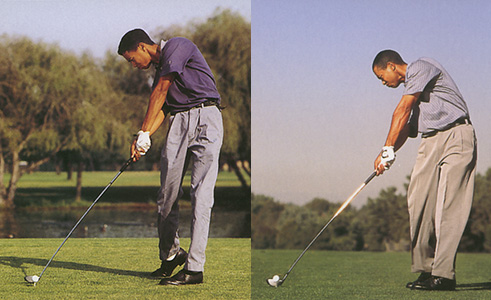
Tiger at impact - age 16 years and eight years later - from reference number [10]
When Tiger was 16 years old, his hip rotation was extremely fast and his hips were about 80-90 degrees open at the impact position. In the second photograph, you can see that Tiger Woods has better control of his swing 8 years later and he has deliberately restrained his hip turn, so that his hips are only approximately 45-60 degrees open at impact. This difference reflects Tiger's greater ability to improve the timing of his hip and shoulder rotation during the downswing, which presumably translates to an increased likelihood of having a square clubface at impact.Many beginner golfers have the exact opposite problem to Tiger Woods' overactive hip problem - they actively rotate their shoulders too soon, and too aggressively, during the early downswing, and they either don't turn their hips enough or they have totally passive hips which are passively pulled into the shot after the shoulders have already rotated around the front of the body. In other words, a beginner golfer's downswing may be totally out-of-synch (shoulders moving first, hips moving second), and a beginner golfer needs to practice getting the sequence of hip-and-shoulder movements correctly synchronised (like the ModelPro golfer).
What about the wrists? When do they become active in the downswing?
Look at this photo-sequence of the ModelPro's downswing.
Downswing sequence - from reference number [2]
Note in image number 2 and 3, that the right elbow still has a right angle bend and the right wrist is still hinged back. In other words, there is no active release movement of the right elbow and right wrist during the first half of the dowswing. It is only after the right elbow reaches the right hip area, and the clubshaft becomes parallel to the ground and situated along the toe line (at the "delivery position" seen in image 3), that the right elbow and right wrist start to release. Until that moment, the clubshaft is held back and this holding back action of the wrists is called "maintaining wrist lag" or "retaining the release angle". During the early downswing, a golfer should have a distinct feeling that he has left the clubhead far behind his hands, and he should have a distinct feeling that the club is not going to be able to catch up with the hands.Note the difference between image 3 and 4. Note that right elbow has partially straightened and that the right wrist is nearly completely unhinged by the time the clubhead reaches the impact position. In other words, the release of the right elbow and straightening of the right forearm only occurs in the late downswing phase - after the hands reach waist level. It is very important to understand that the unhinging of the right wrist is a passive release that occurs in response to the centrifugal forces set in motion by the rotating torso (see the description of the double pendulum action in the overview section of this review). The advanced golfer merely let's it happen by ensuring that the downswing evolves with perfect rhythm and perfect timing. Beginnger golfers may try and push the clubshaft towards the ball at this point in the downswing by pushing with the right hand, but this incorrect pushing-action may disrupt the smooth flow of the swing and/or throw the clubshaft off its desired swingpath. A golfer doesn't have to consciously think about releasing the wrist lag at this point in the swing, because it should happen naturally and automatically. The same situation applies to a boy skipping stones across a still pond. The right wrist release happens automatically and it doesn't necessarily require deliberate conscious thought.
Downswing power is optimised if one maintains wrist lag until the hands reach waist level, and all professional modern, total body swing golfers maintain their wrist lag until this point in the downswing. The longer one can retain the acute angle between the wrist and the clubshaft, the further one can hit the ball. Look at this downswing photo of Ben Hogan.
Ben Hogan downswing - from reference number [11]
One can sense the active hip shift-rotation of Ben Hogan's early downswing action and can sense that he is driving his lower body body towards the ball while keeping the upper body back. Also, note that he is keeping the clubshaft well back behind his hands and that he will only release the clubshaft at the appropriate moment. Ben Hogan maintained an astonishing amount of wrist lag (less than 90 degree angle between the left forearm and clubshaft).
Addendum added September 2007: I have written a short review paper called "How to maximise wrist lag and avoid casting" and it is available in the miscellaneous topics section of this website.
Tiger Woods, like Ben Hogan, also maintains a large amount of wrist lag, which is partly responsible for his amazing clubhead speed at impact.
Tiger Woods' amazing wrist lag - from reference number [12]
Note that Tiger Woods has maintained his wrist lag until this late stage of the downswing (right elbow passing by the right hip area and hands very close to their impact position). From this point in time, the clubhead still has to travel a large distance to the ball, and it will do so at a blindingly fast speed when Tiger Woods finally allows the right forearm and right wrist release to happen. The clubhead will move extremely fast through the impact zone (>100 mph) and the clubshaft will produce a swishing sound just after impact as the clubshaft reaches its point of maximum acceleration. That swishing sound is an excellent sign of a perfectly synchronised downswing, that starts with the large muscles of the body (central core) and then sequentially moves to the periphery with perfectly synchronised timing.Inicidentally, note the clubshaft cutting across the lower half of Tiger Woods' right upper arm when his hands are at waist level, indicating that the clubshaft is on a perfect downswing plane.
The total body dowsnswing
In summary, the major characteristic feature of the modern, total body downswing is the fundamental fact that the generation of swing power involves the total body, and that all the body parts have to work synchronously together in perfect harmony. The dowswing should not be thought of as the mere swinging of the arms and hands across the front of the body. Many beginner golfers think that way, and they simply flail away at the ball with their arms and hands, generating very little swing power. Maximum swing power is the result of a total body movement that evolves in a fixed sequence. A beginner golfer must get the sequence of body movements right, and the sequential body movements must also evolve with perfect rhythm and timing, if the beginner golfer wishes to generate the maximum amount of swing power.Finally, note that a perfect downswing has many admirable features, but is is especially characterised by a sense of balletic poise, grace, and balance - as demonstrated in my favorite golf downswing action photograph.
Ben Hogan in action - from reference number [4]
Note that Ben Hogan's hips have rotated around to the left without any evidence of an excess hip slide (outer edge of the left hip is still within the inner boundary of the left foot). Note that most of Ben Hogan's body weight has been transferred to the left leg, and that the right heel has passively lifted off the ground in response to the hip rotation and weight transfer. Note that the shoulder rotation has not caught up with the hip rotation, and that the shoulders are only slightly open (0-10 degrees open) while the hips are about 45-60 degrees open. Note that Ben Hogan's head is well back behind the ball, although the lower body has moved well forward - causing the spine to be tilted to the right. The greater the amount of forward lower body drive, the greater the degree of spinal tilt to the right.
Near-impact position - from reference number [13]
Note that this golfer, like Ben Hogan, has tremendous forward drive of the lower body in the downswing - the hips are >45 degrees open while the shoulders are only about 10-20 degrees open at the impact position. Note that the right heel is elevated off the ground, and realise that it is passively pulled up by the rotating hips and significant lower body weight shift to the left side (note the straightened left leg, and weight on the outer edge of the left foot). Note that the head is kept behind the ball, and that the spine is consequently tilted to the right.Finally, note that the golfer's grip is neutral and that the clubface is square to the ball - not due to any active hand manipulations, but due to perfectly synchronised upper and lower body movements that cause the body to get to the perfect impact position with perfect timing.
Downswing golf tips (presented in question and answer format)
1. Question: The downwsing is characterised by an early shift-rotation movement of the hips. How much shift is optimum?Answer: In the Ben Hogan photo above, one can see that Ben Hogan's swing is characterised by a considerable amount of lateral hip shift towards the target in the early-mid downswing. That is why Ben Hogan preferred to position his ball far forward (in line with his left heel) for all clubs. Most modern, total body golfers have less hip shift than Ben Hogan, and the degree of lateral hip shift varies from golfer-to-golfer. There are no set rules, other than the fact that one should obviously not slide one's lower body beyond the inside boundary of one's left foot, and one should keep one's head behind the ball.
Note that Ben Hogan has a straight left leg as he nears the impact position, which is the "post" around which the hips pivot. The concept of a firm, straight left leg being a "supportive post" gives rise to the mental image of "hitting into a firm left side". A "firm left side" is an essential feature of the modern downswing because it prevents the hips, and body, from sliding too far to the left. One of the worst downswing faults is to allow the body to slide well forward of the ball during the downswing, and this may happen because the left side is not firm and sufficiently supportive. A golfer should sense that the left side becomes firm and supportive as the left leg straightens, and the lower body should pivot around to the left using the the straightening left leg as a supportive post. You can see that Ben Hogan's left knee has rotated slightly to the left and that his hips have rotated to an open position. Finally, note that Ben Hogan has kept his head well behind the ball, and he has not allowed his head to shift forward of the ball position, which is a definite cause of an excessive, and uncontrolled hip slide.
Conceptually, it is useful to think of rotating around a downswing axis that is situated in the region of the left armpit (an idea offered by David Leadbetter in his book [5]).
Dowswing axis in line with left armpit - from reference number [5]
By thinking of a downswing axis situated in line with left armpit, a golfer is encouraged to initiate the downswing with a left hip shift followed by a pivoting rotational motion around an axis that is located just inside the left foot. In other words, a golfer must be encouraged to shift weight to the left side during the early-mid downswing without sliding excessively to the left. If the golfer slides the lower body excessively to the left during the downswing, then the entire left side "collapses" and this represents a major power leak. A golfer must have a distinct feeling of hitting against a firm left side, and this feeling is achieved if the golfer pivots around an axis situated in line with the left armpit. The two stabilising points are the head and left foot. The head must be kept back behind the ball, and it must act as the upper stabilising point while the left foot represents the lower stabilising point. While the lower body is actively pivoting around the straightened left leg, the upper body is kept back by the stable position of the head behind the ball, and this results in the golfer's distinctive spinal tilt, away from the target, at impact. Many beginner golfers who faithfully follow the advice of keeping the head behind the ball during the entire downswing may develop another downswing fault - they may start to hang back too much and they may have their entire body well behind the ball at the impact position (and they look like they are leaning back away from the target). "Hanging back" is not due to keeping the head behind the ball, but it is due to a failure to drive the lower body forward during the downswing. Although the head must be kept back behind the ball during the entire downswing, the golfer must also ensure that he drives his lower body toward the target in the early-mid downswing and then swivel the hips around to the left (around an imaginary axis located inside the left foot) during the late downwsing - the golfer must think of actively "clearing the left hip" in the early downswing.
2. Question: What is "casting" and why should it be avoided?Answer: Casting refers to the unhinging of the right wrist (and uncocking of the left wrist) at the start of the dowswning, which causes the clubshaft to be propelled forward relative to the left forearm. Think of the mental image of a flyfisherman casting his fishing pole. The motion of casting causes the left forearm-clubshaft angle to approach zero by the mid-portion of the downswing (instead of being approximately 90 degrees - see photo of Ben Hogan above). Many beginner golfers suffer from casting for a variety of reasons. First of all, they initiate the downswing with an upper body move (rotating the right shoulder down towards the ball while simultaneously unhinging their right wrist). Secondly, they often have too much tension in their forearm/wrist muscles, which predisposes to straightenening the wrists in the early downswing. Casting is a major swingfault and it can result in a major loss of power.
Professional golfers keep their wrists relaxed and flexible, so that the wrists can easily hinge more than 90 degrees during the early downswing. Then, they initiate the downswing with a lower body move that rapidly pulls their right elbow down towards the right hip. However, the downward pull on the right elbow does not affect their right wrist lag angle because they have relaxed wrists, and they maintain the right wrist lag angle (hinged back right wrist) throughout the first half of the downswing, until their hands reach the "hitting zone" at waist level. Casting usually becomes less of a problem when beginner golfers learn to start the downswing with an assertive hip shift-rotation, which pulls their right elbow down to the right hip area, while they keep their wrists very loose and relaxed. The SLAP authors [2] recommend that beginner golfers should optimally try to achieve a 45 degree lag angle between the clubshaft and the left forearm in the early downswing, but I think that beginner golfers shouldn't become obssessed by the difficult problem of achieving this 45 degree lag angle. Some advanced golfers are simply better at maintaining a greater amount of wrist lag than other advanced golfers, and it is difficult to learn how to maximise wrist lag through a process of anguished mental cogitation.
Optimising lag angle in the early downswing - from reference number [2]
Addendum added September 2007: I have written a short review paper called "How to maximise wrist lag and avoid casting" and it is available in the miscellaneous topics section of this website.
3. Question: What is the "hitting zone" and should one actively hit with the right hand when one reaches the hitting zone?Answer: Consider this photograph of Nick Faldo approaching the hitting zone.
Approaching the hitting zone - from reference number [7]
In this photo of Nick Faldo, one can see that he is approaching the hitting zone, and his right elbow is below the left arm. The fact that the right elbow is below the left arm is a very good sign that the right arm is keeping up with the left side as the left shoulder rotates and the left hip shift-rotates to the left side in the early downsing. The hitting zone is reached when the right elbow reaches the right hip area and the hands are at waist level. Nick Faldo states that when he gets to that position, he feels that he can hit hard with the right side. Hitting hard with the right side should not simply be thought of as an active unhinging motion of the right wrist, but rather a sense that the entire right side (right shoulder, right forearm, and right hand) is going to continue its drive down towards the impact zone. A golfer should have a sense that he is going to hit through the impact zone with his entire right side, and that his right shoulder is going to move down and forward under the chin, and that the entire right side will continue to move through the impact zone to a complete followthrough.Nick Faldo has stated that on a good day, he feels that he can hit hard with the right hand, implying that the right hand becomes active when unhinging starts to occur in the hitting zone. If Nick Faldo thinks that he can only actively hit hard with the right hand on a good day, when his timing is absolutely perfect, then it implies that one should not think of actively using the right hand under normal conditions. Most importantly, one should not think of actively pushing with the right hand when the hands reach the hitting zone, because it may cause the right wrist to be palmar flexed (flipped) by the time it reaches the impact position. Palmar flexion of the right wrist produces a bowed right wrist and a cupped/scooped left wrist at impact, and it's a major cause of a loss of power and control (see the glossary of wrist movements if you need to understand the terms "scooped", "cupped", "bowed"). A scooped left wrist at impact should specifically be avoided (much more about this issue in the impact section of this review).
4. Question: Which downswing body movements allow a golfer to accurately square the clubface at impact?Answer: Squaring the clubface at impact is the end-result of a perfectly executed, perfectly coordinated total body swing. It is not the end-result of any hand manipulation in the pre-impact zone. In fact, a professional golfer avoids any active manipulation of the club with his hands, and he attempts to maximise accuracy by getting his entire body into a picture-perfect impact position at the precise moment the clubface reaches the ball.
Body position of ModelPro golfer at impact - from reference number [2]
If a golfer gets his body into this model position at impact, then it will ensure that the clubface is square to the ball at impact. Most PGA tour-quality golfers, who square their clubface at impact, look like this model at impact. Getting to this perfect impact position is the end-result of many complex body movements that harmonise in perfect synchrony during the downswing. A golfer essentially has to transfer his weight to the left side, and first clear his hips so that the right elbow can brush past the right hip as the right forearm starts to extend, thus allowing the clubhead to approach the ball from an inside direction. If the sequential timing of all the moving body parts is perfect, and the grip perfect, then the clubface should be square at impact. A square clubface at impact is the end-result of a perfect swing, and not the end-result of some magical secret formula (available online at a golf-related website for $99)!
5. Question: What is the transition move, and should it occur before the backswing is completed?Answer: The transition time period is the time period when the golfer is thinking of transitioning from the backswing to the downswing, and the transition move is a description of critical body movements that occur at that time. This is an extremely complex issue, and I would highly recommend that you buy the book "Swing Like a Pro" [2] to gain insight into the transition move. The SLAP authors devote an entire chapter to the "transition move" and they provide the best description of the transition move that I have ever read. Basically, during the transition time period, a golfer should be thinking of moving his body in two directions at the same time. The transition move optimally begins before the backswing is complete, and the SLAP authors recommend that a golfer should start rotating the lower body back towards the target before the backswing is complete - starting when the clubshaft is vertical to the ground during the backswing. If the transition move is perfectly timed, then the upper torso (shoulders) will still be moving away from the target while the lower body (hips) starts moving towards the target. This has three benefits. First of all, it increases dynamic coiling of the body - think of twisting a partially coiled up spring with one's hands, with the right hand holding the top of the spring turning clockwise while the left hand holding the bottom of the spring is turning counterclockwise - and potentially enhances swing power. Secondly, as the lower body rotates towards the left, the hips become square and the body is in a momentary "sitting down" position where the body weight is recentered between the feet. That temporary split-second "sitting down" position is a very stable position to be in when the downswing starts in earnest - when weight starts to shift to the left and when the entire torso starts to rapidly uncoil. Thirdly, the initial lower body shift-rotation moves the clubhead into the correct swingpath as previously described (moving smoothly away from the body, away from the ball-target line, in a backwards-directed swingarc). I have studied the swings of many professional golfers in slow motion and very few of them have a perfect transition move. Most amateur golfers will probably never master the type of transition move recommended by the SLAP authors, but they will greatly benefit if they at least ensure that the transition between the backswing and downswing is as smooth as possible. A golfer should definitely not come to a full stop at the end of the backswing, and he should definitely not start the downswing abruptly with a sudden, jerky downswing movement. Professional golfers seem to transition smoothly from the backswing to the downswing without any body or clubhead "hiccups", and amateur golfers should mimic their behaviour. In his book [13] Jim McLean writes-: "In all the great swings I have studied, there is no evidence of a "stop" and a "start" that together reverse the direction of the club from backswing to downswing. Instead, I see a smooth flowing transition". This strong belief in a smooth transition is echoed by Ernie Els in his book [6] when he states-: "If there is one key message in this transition from backswing to downswing, I think it is to keep everything smooth".
6. Question: In his book [10], Tiger Woods states in capital letters-: "START DOWN SLOW. The beginning of the downswing can't be rushed. You want your swing to gather speed gradually, so that everything works in sequence and the clubhead reaches its maximum speed at impact." Is that good advice?Answer: That's definitely good advice, and every golf instruction book that I have read echoes Tiger's admonition - start down slowly. I have previously described the dowswing sequence of kinetic body movements, and this sequence has to occur exactly as described. The first muscle groups to move are the large muscle groups of the central body, and they cannot move very fast. The hips need time to unwind, and the right shoulder and arms should not start moving too soon. In his golf instructional book [6], Ernie Els states-: "One of the mistakes I see a lot of amateurs make when they are looking for extra distance is snatching the club from the top." Snatching the club from the top is a major mistake which results in a non-synchronised downswing and too steep a clubhead swing path. The clubhead should travel in a smooth rounded swingarc down towards the ball, and that can only happen if the downswing body movement sequence is correctly sequenced and timed (lower body first, upper body second).
In his book [14] David Leadbetter writes-: We talk about the swing being a chain reaction, and nowhere is it more so than in this sequence from the top. The big danger that you have to be aware of is being impatient, rushing the changeover and trying to force the club down. You have to resist that urge to lunge with your body at the ball. Let the motion unfold naturally as gravity takes over."
7. Question: A golfer states that he often feel "blocked" in the downswing and he feels that his right elbow hits the right hip, instead of sliding effortlessly past his right hip. How can the golfer easily get his right elbow around the right hip?
Answer: The hips must first clear so that the right elbow can occupy the position originally occupied by the right hip. That's why it is so important to get the sequence of downswing body movements perfectly synchronised. During the initial downswing, the hips shift-rotate to the left as the right elbow is rapidly brought down towards the right hip area. If the shift-rotation of the hips occurs first, then the right elbow will occupy a position alongside the right hip that was previously occupied by the right hip (before the pelvis shift-rotated to the left). If the arms are brought around the body without first moving one's hips, then the right elbow will be forced to circumnavigate the body in front of the right hip and that circuitous path will cause the clubshaft to move outside the toe-line and then subequently back towards the body along an outside-in swingpath. That outside-in swingpath is unacceptable because the likely end-result will be a weak slice. Clearing the right hip first allows the right elbow to closely hug the body as it slides past the right hip area and this coordinated, correctly-sequenced motion ensures that the clubshaft will correctly approach the ball from an inside track when the right forearm release finally occurs.
Tiger Woods downswing - as seen from behind
In image 1, I have placed a red line alongside Tiger Woods' right hip when he is the end-backswing position. Note that Tiger Woods' right hip is angled slightly to the left, while his spine is angled slightly to the right at the end-backswing position - this is the result of an excellent backswing pivot, which creates space under the right shoulder for the right arm/elbow to descend down towards the ball in the early downswing. In image 2, Tiger Woods starts the downswing with a hip shift-rotation movement, which causes the right elbow to be pulled inwards towards the right hip. In image 3, the right elbow is close to the right hip, and is occupying the space previously occupied by the right hip (red line). In image 4, the right elbow slides forward just in front of the right hip, as the hips continue to shift-rotate to the left. Note that "clearing the right hip" allows the clubshaft to approach the ball from an inside track.
As an aside, note that Tiger Woods appears to be "'standing up" as he nears the impact position (image 4). This "standing up" appearance is due to the fact that his left leg is straightening in the late downswing, which causes the left pelvis to be slightly higher than the right pelvis. At the end of his backswing, Tiger Woods' right pelvis was slightly higher than the left pelvis (image 1). Then, in the early downswing, when he squares his hips, the pelvis becomes level and slightly lower and his head drops slightly - due to increased knee flexion in both knees. Then, as he approaches impact, the pelvis lifts up slightly with the left pelvis being slightly higher than the right pelvis - causing the 'standing up" appearance.
8. Question: Is there a simple drill that can help a golfer assess whether his overall downswing is characterised by perfect synchrony and perfect timing?Answer: Once a golfer has a clear mental idea as to how to perform a downswing with perfect synchrony/timing, then he should perform a full swing holding onto the clubhead end of a golf club (eg. driver). If he performs a full swing correctly, with perfect synchrony and perfect timing, then the club handle should reach maximum acceleration in the immediate post-impact zone - and it should produce a swishing sound that is audibly locatable to that very spot. If the swishing sound is muted and comes from a spot in the pre-impact zone, then there must be something wrong with the downswing's synchrony/timing.
9. Question: Is the spine angle the same during the backswing and downswing?Answer: A golfer adopts a bent-over spine at address, and that spine angle should be maintained throughout the backswing and downswing.
Spine angle - from reference number [5]
Note how the diagram demonstrates how a golfer should maintain a constant bent-over spine angle during the backswing and downswing. In fact, the golfer should maintain that constant spine angle during the post-impact period, and it is only during the latter part of the followthrough that the golfer becomes more erect. During the backswing the golfer should rotate his shoulders at right angles to the bent-over spine, and during the downswing the shoulders should also rotate at right angles to the constant spine angle. In the early followthrough, the head will start to rotate to the left while the spine angle remains unchanged - that gives the golfer an appearance of laying his head down on a pillow during the early followthrough period.
Image of a head on a pillow - from reference number [15]
If a golfer has a mental image of laying his head down on a pillow during the early followthrough period, then it may help him keep a constant spine angle during the downswing period. Note that the golfer needs to rotate his head to the left and not lift his head up (which often causes the entire spine, and upper body, to be lifted-up). The golfer must feel that he is "staying down on the shot" during the late downswing and impact period, and there must be a distinct feeling that the right shoulder is going to drive forward under the chin. If the head and chin is rigidly kept down (looking down at the ball) for too long, then it may impede the forward movement of the right shoulder under the chin. By rotating the head to the left immediately after impact, the golfer is encouraged to swing the right shoulder and club through the impact zone without any excessive lifting-up motion of the upper body.
10. Question: If a beginner golfer starts the downswing with an upper body movement (right shoulder rotation) and produces an "upper body dive" movement, the SLAP researchers state in their book that it causes an outside-in swingpath. Does it also cause a reduction in swing power and clubhead speed?Answer: An over-the-top (OTT) right shoulder movement at the start of the downswing causes a major loss of swing power and clubhead speed for multiple reasons.
Anonymous golfer's "upper body dive" downswing movement
Note that the anonymous golfer starts the downswing with a right shoulder rotation that throws his hands and clubshaft over the toe-line at the very start of the downswing. That OTT movement forces the hands, and clubshaft, to approach the ball along a steep angle of attack. Note in image 2 that the clubshaft is approaching the ball from above the hands, and that the right wrist has to downcock (ulnar deviate) to get the clubhead down to the ball from that position. Downcocking the right wrist is a much weaker ball-striking right wrist movement than unhinging (palmar flexing) the right wrist.
Ernie Els versus the Anonymous golfer at the "delivery position"
The "delivery position" is defined as the downswing position where the clubshaft is in line with the toes, and parallel to the ball-target line and parallel to the ground. In the above composite photograph, Ernie Els' clubshaft is in the delivery position. Note that Ernie Els gets into the delivery position with his clubshaft coming from behind the hands (also see the composite image of Adam Scott which demonstrates that the clubhead comes from behind the hands - position 4 shows the clubshaft position in line with the right forearm, while image 5 shows the clubshaft at the delivery position, and one can appreciate the incontestable fact that the clubshaft must get to the delivery position from behind the hands). Note that Ernie Els' right wrist is hinged back (dorsiflexed) in the above photo, and that when the right hand releases the club from the delivery position, that the right wrist must unhinge (palmar flex) so that the clubhead approaches the ball along a shallow inside-track. Unhinging the right wrist is a much more powerful ball-striking movement than downcocking the right wrist. Think of a professional tennis player hitting a strong forehand drive down the court. The tennis player will throw his body and right arm into the ball in order to generate the maximum tennis racket speed, and he will end the pre-impact phase of the forward swing with an unhinging movement of the right wrist. The tennis player would not use a slicing action to hit a powerful shot. In fact, a tennis player uses a slicing action to minimise forward ball speed - and a slicing action involves an abbreviated arm swing with a downcocking wrist action. A golfer should likewise avoid a downcocking right wrist action in the downswing if he wants to maximise clubhead speed, and that's why he should ensure that the clubshaft approaches the ball from behind the hands, and not from above the hands. In other words, a shallow angle of attack along an inside-track is the optimum downswing path, and it will also help to maximise swing power.To understand a second major reason why an OTT upper body movement, at the start of the downswing, can rob the golf swing of much potential swing power - study the above four-sequence image of the anonymous golfer's "upper body dive" movement. Note that the anonymous golfer only moves his upper body at the start of the downswing and his lower body doesn't move actively. The hips are eventually pulled passively into the shot in the late phase of the downswing, and there is very little lower body weight transfer to the left during the downswing - note that the anonymous golfer's right foot is still "fixedly" planted on the ground well after impact (image number 4).
Consider a face-on view of the anonymous golfer at the near-impact position.
Two golfers at the near-impact position - Aaron Baddeley and the Anonymous golfer
Note that the anonymous golfer has very little lower body movement to the left and he appears to be statically flat-footed at impact. At the near-impact position, the anonymous golfer has square hips and he still has considerable weight on the right foot (compared to Aaron Baddeley who has open hips, and only the right toe area of his right foot is still touching the ground). Note that the anonymous golfer's spinal tilt angle is the same as it was at address, demonstrating that the lower body's weight has not shifted to the left (while Aaron Baddeley's spine is tilted away from the target signifying excellent lower body weight transfer to the left side). In other words, the anonymous golfer is only using his upper body to generate swing power, and he appears to be slapping the ball with his right arm/hand (while Aaron Baddeley seems to be using his total body to generate swing power). Finally, note that the anonymous golfer's left elbow is collapsing at impact - because he is not pushing through the shot with his right shoulder and right hand (note how the hands are behind the ball at impact). This will result in a chicken-wing appearance of his left arm in the followthrough phase of his swing (see question number 2 in the followthrough section of this review to understand the term "chicken winging" and to see a photographic image of the anonymous golfer's post-impact "chicken-winging" action).
11. Question: Leslie King states in his "arm swing" tutorial [16] that the arms should be directed down towards the ball in the downswing while maintaining the shoulders in the fully turned position. What does he mean by that statement, and how does a golfer, using the modern, total body golf swing, ensure that the arms travel down to the ball along the correct track?Answer: I will start off by describing what Leslie King means when he states that the arms should start moving along the downswing path while the shoulders remain in the fully turned position. Leslie King believes in an active arm swing, and he believes that the arms have to pass along a downswing track down to the ball, and that the downswing track is determined by the position of the shoulders at the end-backswing position. Usually, the shoulders have turned perpendicularly around the bent-over spine in the backswing, and the shoulder angle at the end-backswing position slopes downwards towards the ball-target line, so that a line drawn across the shoulders will hit the ground about 2-4' beyond the ball. Then, during the downswing, Leslie King instructs a golfer to keep the shoulders fully turned at a constant angle, while swinging the arms actively down to the ball.
Downswing arm track - from reference number [16]
In the above diagram, one can see the arm and clubshaft track (downswing clubline) that Leslie King recommends the arms and clubshaft should follow, and this will only happen if the shoulders are kept in their fully turned position. Leslie King believes that it is a major mistake to prematurely turn the shoulders when starting the downswing because a premature shoulder turn could throw the arms off the correct downswing clubline track.For example, many beginner golfers start the downswing by turning the shoulders horizontally, and they incorrectly throw the right shoulder and hands over the toe line in an over-the-top (OTT) move.
Right shoulder OTT move - from reference number [16]
Leslie King states that a golfer must avoid starting the dowswing by turning the shoulders and throwing the right shoulder and hands over towards the ball-target line, because that will result in an outside-in downswing clubhead swingpath.Leslie King also believes that a beginner golfer must avoid using his right hand to push the clubshaft over the toe line at the start of the downswing, because that will also cause an outside-in downswing clubhead swingpath.
Right hand pushing clubshaft over toe-line - from reference number [16]
Leslie King believes that if a golfer can avoid throwing the clubshaft over the toe line at the start of the downswing, by avoiding a right hand push and an OTT right shoulder movement, then it is very likely that the arms will track along the correct downswing track.In the modern, total body golf swing, the golfer starts the downswing with an active lower body movement (shift-rotation of the hips), followed by an active shoulder rotation. The arms are finally pulled passively across the front of the body as a result of the shoulder rotation (via a double pendulum swing action). How does the golfer ensure that the arms follow the correct downswing track if the arms are passively pulled through the shot as a result of a double pendulum swing action?
Consider this composite image of Aaron Baddeley's early downswing.
Early downswing arm and hand movement - from reference number [1]
Note that Aaron Baddeley's arms and hands are moving along a perfect downswing track. How does this happen if arm/hand movements are passive in the modern, total body golf swing?The correct downswing movement of the arms/hands occurs if the hands are in a good position at the end of the backswing and if the downswing starts with a lower body movement. The initiating movement in the downswing is a shift-rotation of the hips to the left (squaring of the hips with a lateral shift of the pelvis to the left) and when this occurs it causes the right arm and right elbow to be pulled downwards in the direction of the right hip. This gets the arms-hands to passively start moving along the correct downswing track. Then, as the downswing evolves, the shoulders must rotate near-perpendicularly around a constant spine angle to ensure that the arms continue to move along the correct downswing track.
Shoulders rotate near-perpendicularly around a constant spine angle to eventually be on the RSP line in the late downswing - from reference number [1]
When Aaron Baddeley starts the downswing, the hips shift-rotate to the left, and the hips continue to rotate horizontally. However, the shoulders start to rotate fractionally later than the hips and they rotate near-perpendicularly around a constant spine angle. The maintenance of a constant spine angle and a shoulder turn that is nearly perpendicular to the bent-over spine, allows the clubshaft to be pulled passively along an optimum downswing track (similar to the track in the Leslie King model).
12. Question: Vijah Singh is a long hitter, and yet he doesn't have the right hand firmly in contact with the grip at impact (only his right thumb and right index finger are holding the grip in a pincer grip). Doesn't that limit his clubhead speed (swing power) if he isn't using his right hand to actively hit the ball at impact?Answer: The fact that Vijah Singh can drive the ball >300 yards, without having his right palm pushing aginst the clubshaft at impact, demonstrates an important point. Maximum swing power, and maximum clubhead speed, is generated by movements that occur in the downswing - well before impact.
Vijah Singh driver sequence - from reference number [11]
Note Vijah Singh's body position at the end-backswing position (image 4). Note that his shoulders have turned >90 degrees, and that his hips have turned <45 degrees (compared to the address position). Then, note what happens at the start of the downswing (image 5). Vijah Singh starts the downswing with a "hip-squaring" hip shift-rotation movement. By squaring the hips and achieving a "sitting down" look, the lower body has provided a "temporary" stable platform for the active mid-upper torso rotation that occurs a fraction of a second later, as part of the synchronised sequence of sequential downswing movements. Note how fast (and how far) the right shoulder moves down towards the ball, and eventually under the chin, between images 4 and 8. The right shoulder moves along an arced-track (right shoulder plane), that is a perpendicular rotation around the bent-over spine, during the downswing. Note how the shoulder plane is tilted towards the ground in image 8 (and that a line across the shoulders will hit the ground about 2 feet beyond the ball), thus proving that Vijah Singh has maintained a constant spine angle and turned his right shoulder perpendicularly around the bent-over spine throughout the downswing and early followthrough. Consider the muscles forces that drive his right shoulder around his body during the downswing. The body-torquing forces are generated by the large muscles of the mid-upper torso, and they cause the mid-upper torso to swivel around the rightwards tilted spine during the downswing. Those central torque forces, operating at the body's central hinge point, then cause the clubshaft to swing passively around the body via a centrifugal action (according to the golf physic principles of a double pendulum swing action model - see reference number [17] for further details). Once the clubshaft is set into motion (in response to torque forces generated at the central hinge point), then Vijah Singh only needs to allow the clubshaft to be propelled down towards the ball - in response to these centrifugal forces - without any mechanical interference.
"Educated hands" are not needed to generate swing power in the total body swing. "Educated hands" are mainly needed for fine control - fine control of the clubshaft's movements as it responds to the centrifugal forces set into play by the central body's torque generator (large muscles of the lower-mid-upper torso). Once Vijah Singh gets his clubshaft into the "correct downswing slot" in the early downswing, his "educated hands" merely guide the clubshaft as it is whipped around the body in response to centrifugal forces. He doesn't need his hands to actively provide swing power in his full golf swing. He needs "educated hands" for fine control.
References:
1. V1 Home Swing Analyser website. http://v2.v1home.com
2. Swing Like a Pro. Ralph Mann and Fred Griffin.
3. Five Lessons. The Modern Fundamentals of Golf. Ben Hogan.
4. The Fundamental of Hogan. David Leadbetter.
5. The Golf Swing. David Leadbetter.
6. How to Build a Classic Swing. Ernie Els.
7. A Swing for Life. Nick Faldo.
8. Jim McClean website at http://jimmclean.com
9. The Eight-Step Swing. Jim McLean.
10. How I Play Golf. Tiger Woods.
11. Redgoat at smugmug.com. Available at http://redgoat.smugmug.com
12. Tiger's New swing. John Andrisani.
13. The Complete Encyclopedia of Golf. Edited by Paul Foston.
14. 100% Golf: Unlocking Your True Golf Potential. David Leadbetter.
15. Maintain this forward tilt throughout the swing for solid contact. Martin Hall.
Available online at http://www.golfonline.com/golfonline/yahoo/article/0,22348,469146,00.html
16. Leslie King. Arm swing tutorial.
Available at http://www.golfpro-online.com/tuition/lking/index.html
17. David Tutelman's double pendulum swing action model.Available at http://www.tutelman.com/golfclubs/DesignNotes/swing1.php?ref=golfcoast
